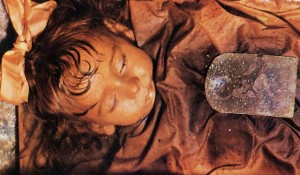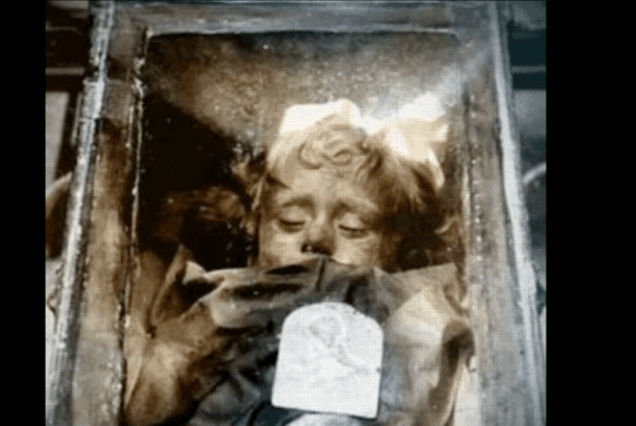
Sleeping Beauty Opens Her Eyes:
Throughout history, different cultures have adopted their own traditions when it comes to preserving the dead. There are far too many fascinating mummies to choose just one as the most interesting, but the most heartbreaking might center on the corpse of a little girl, who has since earned the nickname “Sleeping Beauty.”

In life, the little girl’s name was Rosalia Lombardo. Born in 1918 in Palermo, Italy, little Rosalia was only two years old when her short life came to a tragic end. Following her death (purportedly after coming down with a bad case of pneumonia), her hysterical father approached a skilled embalmer and asked him to preserve Rosalia’s body.
The embalmer graciously agreed and pumped her corpse with his own special formula, believed to be “one part glycerin, one part formalin saturated with both zinc sulfate and chloride, and one part of an alcohol solution saturated with salicylic acid.” He did such a fantastic job that Rosalia is still in remarkable condition, despite having died almost 100 years ago. )Though it must be said that the years have not been entirely kind; It has been reported that her body now exhibits signs of decomposition.)
Since her death, she has slept in a small glass case in the Capuchin Catacombs (a convent in Palermo, Sicily), where tourists once flocked to sneak a glimpse at the girl time seems to have forgotten. Many of them have captured several images where Rosalia’s eyes appear to open and close.

It’s certainly a spooky sight, but there’s nothing supernatural about it. According to Dario Piombino-Mascali, a curator at the Capuchin Catacombs, “It’s an optical illusion produced by the light that filters through the side windows, which during the day is subject to change.” It seems unlikely that the effect can merely be chalked up to a trick of light though. Pay close attention to the shadows.
If that isn’t the case, other have suggested that changes in humidity might be to blame.
The Dancing Death:
Back when we had had no idea about penicillin and germs (and, you know, long before modern hygiene practices were a thing), plagues were rather common. In fact, the bubonic plague—otherwise known as the black death—alone wiped out an estimated 200 million people in the 14th century: making it one of the most deadly plagues in history. Now, let me tell you all a thrilling tale about one of the most bizarre: The Dancing Plague.

As unusual as it sounds, in 1518, one woman started marching to the beat of her own drum. In the weeks that followed, more than 400 people from the surrounding village joined her. It’s hard to separate the legends from the truth with what followed, but, as the story goes, the growing crowds just could not stop dancing. They literally danced until they were dead (no word on whether heads rolled). Most of the casualties were from exhaustion, but many others died after having heart attacks or strokes.
In what must be the worst medical advice of all time, doctors—and I use the word loosely—suggested that, in order to be cured, the dancers needed to dance non-stop, day and night. (The prescription for not dancing being more dancing was only slightly contradictory. Alas, those were strange times).
Since there was no outward scientific explanation, many believed that the dancing was the result of dark magic, drugs or stress-induced psychosis. Another hypothesis says that the victims were impacted by some natural phenomenon that caused their blood to become significantly hotter. If you ask me, they overlooked the most plausible scenario: Aliens. Giorgio A. Tsoukalos would (probably) agree.
The Sentient(?) Decapitated Heads:
Back in the day, one of the primary methods of execution—ironically, it was also one of the most humane—was the guillotine. This instrument is basically a wooden frame with a long blade attached. When prompted to, the blade loosens and is sent barreling down on the person’s neck, completely severing the head from the body.
However, many times after the executions, witnesses claimed that the severed heads displayed outward signs of semi-consciousness. Understandably, many people came to the conclusion that some of these things (including the blinking of the eyes) were natural ticks that follow a person’s death (involuntary movements, and the like). Others weren’t that sure. Among them was a man named Dr. Beaurieux.

While witnessing the 1905 execution of a convict, Beaurieux saw more than he bargained for. He recounted:
“Here, then, is what I was able to note immediately after the decapitation: the eyelids and lips of the guillotined man worked in irregularly rhythmic contractions for about five or six seconds. This phenomenon has been remarked by all those finding themselves in the same conditions as myself for observing what happens after the severing of the neck…”
“I waited for several seconds. The spasmodic movements ceased. The face relaxed, the lids half closed on the eyeballs, leaving only the white of the conjunctiva visible, exactly as in the dying whom we have occasion to see every day in the exercise of our profession, or as in those just dead. It was then that I called in a strong, sharp voice: “Languille!” I saw the eyelids slowly lift up, without any spasmodic contractions–I insist advisedly on this peculiarity–but with an even movement, quite distinct and normal, such as happens in everyday life, with people awakened or torn from their thoughts.”
“Next Languille’s eyes very definitely fixed themselves on mine and the pupils focused themselves. I was not, then, dealing with the sort of vague dull look without any expression, that can be observed any day in dying people to whom one speaks: I was dealing with undeniably living eyes which were looking at me. “After several seconds, the eyelids closed again, slowly and evenly, and the head took on the same appearance as it had before I called out.”
“It was at that point that I called out again and, once more, without any spasm, slowly, the eyelids lifted and undeniably living eyes fixed themselves on mine with perhaps even more penetration than the first time. The there was a further closing of the eyelids, but now less complete. I attempted the effect of a third call; there was no further movement – and the eyes took on the glazed look which they have in the dead.”
“I have just recounted to you with rigorous exactness what I was able to observe. The whole thing had lasted twenty-five to thirty seconds.”
[Reference: “A History of the Guillotine” by Alister Kershaw]
This definitely wasn’t the only instance people made similar claims. In another example, when Charlotte Corday was executed, one of the executioners gave her a stern slap across the face (perhaps as a show of disgust for her role in the assassination of Jean-Paul Marat—an important figure in the French Revolution). When he lifted up the head, Corday’s eyes followed the eyes of the executioner, with a look of indignation slowly etching across her face.
As absurd as it might sound, there have been several studies that show the brain still functions shortly after being severed from its host body. In 2011, a paper was published that revealed electrical activity continued for more than 17 seconds after the heads of rats’ were removed. After that window of time passed, a large “electrical” wave propagated through the brain, which might signal irreversible brain death (the point at which brain functions cease and neurons start to die. Not to be confused with biological death, when all bodily functions fail).
Moreover, it might be possible to reanimate said brain cells, at least that’s what one study asserted.
How Corpses Might End the World:
We’ve all heard about the disastrous scenarios we might face if global warming continues at its current rate. There are rising sea-levels to worry about; catastrophic changes to delicate ecosystems (the Great Barrier Reef might be the most well-known example); and huge, unprecedented storms—just to name a few.
One of the most unusual scenarios says that global warming could be responsible for unleashing some of the most deadly plagues known to man. Many of them have long disappeared off the radar, but it’s possible, in theory, that global warming could allow bodies frozen in some of the coldest places on Earth to thaw out, perhaps people who died from a number of deadly, almost-eradicated diseases… like the still-feared smallpox virus (it took the lives of between 300 and 500 million people in the 20th century alone).
As an interesting point, in 1991, a team of Russian bioweapons experts trekked off to Kolyma River in Siberia (one of the coldest places on Earth, which makes it the perfect place for natural mummification to take place) to explore the above possibility, specifically looking for smallpox victims preserved in the Siberian permafrost. To quote the author of a 2002 paper:
“Worried that spring flooding might wash the remains into inhabited areas—and possibly resurrect the smallpox virus—authorities in Yakutsk had summoned the team to this nightmarish place near the Kolyma River. The camera zooms in as the researchers huddle around a mummified child half-submerged in thawing mud.”
“They gently peel away a few layers of deerskin clothing to reveal blackened skin pocked with blemishes characteristic of smallpox pustules. As they cut into a wizened leg, liquid oozes from the spongy flesh. Some minutes later they finish their work and douse the tomb with disinfectant to try to prevent anyone else from carrying smallpox out with them—accidentally or otherwise.”
[Reference: “Is Live Smallpox Lurking in the Arctic?“]
They collected samples from the child’s tomb and took them back for inspection, finding that the samples didn’t contain even a hint of smallpox. It could be that the evidence was destroyed thanks to a continuous cycle of the cadaver freezing over and thawing out, as such, they could not rule out the possibility of global warming resurrecting any one of these nasty viruses. However, a member of the CDC went on record and said “No one feels there’s a serious chance that global warming will melt the permafrost and unleash an epidemic.”
To be fair, if they did reemerge somehow, things have changed monumentally since the diseases were prominent. Personal hygiene has improved; we have access to a lot of potentially life-saving medicines and of course we have vaccines, but I would rather not find out.
Lastly, and I definitely saved the worst entry for last:
Japan’s Real-Life ‘Human Centipede’ Experiments:
During the early to mid 20th century, Japanese scientists took a page from Josef Mengele: a scientist so infamous for his work with the Nazi party, he eventually earned the nickname the ‘Angel of Death.‘ Like Mengele, a covert faction within the Japanese military began performing horrific medical experiments on living, unmedicated, conscious people (only most of their “patients” were prisoners of war). And we’re not just talking about minor or cosmetic surgeries, but some very troubling, human centipede-esque stuff.

The experiments varied widely. In one case, the doctors surgically removed a woman’s hand and foot and proceeded to swap them out. Meaning, she had a foot as a hand and a hand as a foot. That was only the start of the depravities preformed by Unit 731. In another experiment, they removed the stomach out of a live patient just to see what happens when you attach the esophagus to the intestines. (spoiler alert, nothing good)
If that’s not bad enough, the facilities that housed Unit 731 reportedly had the equipment to generate more than 30 kg of Yersinia pestis—the bacteria responsible for the bubonic plague—in merely a few days. As we touched on before, it was so deadly, it obliterated between 30 to 60% of Europe’s population in the 14th century. During one such outbreak, called the Great Plague of London, 1 in 5 residents died.
Some of their work did prove beneficial to science (as did select pieces of scientific research conducted by the Nazi party), but that doesn’t negate the ethical abominations they committed in its name.
[/toggle]
Want more morbidity? Check out the following articles: “Death & Decomposition in Space,” “What Can We Learn From the Well-Preserved “Franklin Expedition” Mummies.” “The World’s Most Horrific Graveyard,” and “Could The Blood of the Young Make Us More Youthful?”
From Quarks to Quasars is two people, Jaime and Jolene. We want to make the world a more sciencey place. We’re doing that, but with your help, we can do even more.
FQTQ takes a lot of time, money, and effort. Here, you can support us, get to know us, and access extra content: